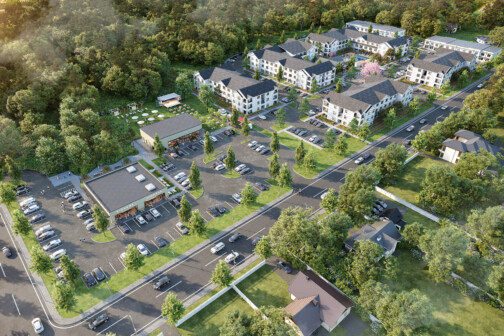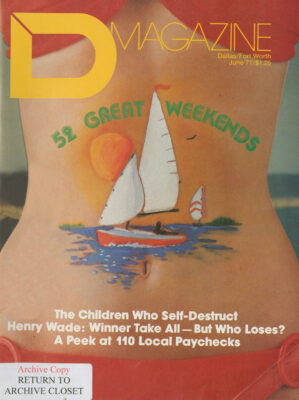Surtran, Airtrans, Dial-a-Bus, Hop-a-Bus . . . call’em anything you like, they’re outdated. Fifty years ago Dallas had its. mass transit problems solved quicker, cleaner, and cheaper than it’s apt to have in the next two or three decades.
Fifty years ago you could hop something called the electric interurban every few minutes and travel a 365-mile rail network out of Dallas that reached Fort Worth, Waco, Denison-Sherman, Corsicana, Terrell, Denton, Cleburne, and a few dozen – towns and villages in between.
The interurban cars could speed along with no smoke or smell on their well maintained private rights-of-way at an effortless 60 miles per hour, giving you a most delicious sensation of velocity as you stood at the front of the car, its nose swaying at high speed . . . and remember, this was before superhighways, in the days when you tested your new automobile by seeing if it could pull Chalk Hill in high.
The glorious thing about the interur-bans was they were so easy to use. They ran often – usually once an hour, at least – and they made good time, even for today: Dallas to Sherman in just over two hours, to Waco in less than three. And the ride was cheap: 30 cents from downtown Dallas to Richardson, 60 cents to Waxahachie, 65 to Ennis or McKinney, $1.50 to Denison, and just a few cents from one town to another up and down the line.
These lordly electrics weren’t just overgrown trolley cars. They didn’t rattle along the rails. They rumbled. Even their whistle and bell had a deeper, imperative tone. On the city streets they looked impatient to be out where they could fly.
And talk about class: some lines pulled parlor cars with individual upholstered or (in summer) wicker armchairs, with leaded pane, stained glass arch windows, rear observation sections with picture windows all around, and refreshments aboard. The Texas Electric Railway even tried diners for a while.
In addition to the deluxe splendors, even the humble local cars had smoking compartments forward, had padded leather bucket seats, and sported toilets (an indoor comfort a good many of their rural passengers had not). The Texas Electric – longest interurban line in Texas – also had cars with railway post office sections with outside mail slots so that you could post a letter and have it delivered up and down the line that same day.
The first interurban line in the Dallas area was the Northern Texas Traction Co., built in 1902 between Fort Worth and Dallas. One would have thought Dallas and Fort Worth, being the largest near-cities in the state, would have been the first inter-city line in Texas but that honor went to Denison and Sherman, where an 11-mile electric railway had been built in 1900. (Electric lines were almost always called “railways” not “railroads” for some reason.)
The original NTT terminal in Dallas was on Main, through to Commerce, just west of St. Paul Street. The NTT cars crossed to Oak Cliff on the rapid transit trestle (where the Jefferson viaduct now stands), went out Jefferson Avenue and passed through Arcadia Park (which was built as an interurban suburb), Grand Prairie, Arlington, and Handley before entering Fort Worth. In 1911 the route to Cleburne, by way of Burleson, from Fort Worth was opened by the same ownership.
In 1908 a Dallas group built the Texas Traction line to Sherman where it connected with the Denison-Sherman interurban. By 1913 the Southern Traction Co. was operating down to Waco, a 97-mile stretch, then a few weeks later the line to Corsicana, 54 miles away, was opened. In 1916 Texas Traction, Southern Traction, and the Denison-Sherman interurban line were combined into the Texas Electric Railway system of some 240 miles.
J.F. Strickland was founder and first president and R.B. Stichter was the general manager. Later, James P. Griffin headed the line for many years and H.G. Floyd was general superintendent for the last 25 years or so of Texas Electric’s life. (I once applied to Mr. Floyd for a brakeman’s job and he refused to let me even entertain the notion. “The interur-bans are done for,” he told me, “you go to college and forget the electrics.”)
The Denison-Sherman run of the Texas Electric used Dallas streetcar rails out to Matilda Street, then it went private rightof-way straight north (you can still see a slightly humped median on parts of Matilda) to the town of Vickery, where it crossed Greenville Avenue, skirted the old Reynolds Orphans Home (site of today’s Presbyterian Hospital) and continued through Huffines, Richardson, Piano, Allen, McKinney, Melissa, Anna, Van Alstyne, Howe, Sherman and Denison.
The Waco division and Corsicana cars passed south over the transit trestle, pausing at Oak Cliff Junction, perhaps, to pick up baseball fans from old Gardener Park, then proceeded south over the Trinity Heights viaduct – a magnificent structure which carried the cars some 40 feet in the air and 1,000 feet in distance – to the Monroe shops in south Oak Cliff where the Corsicana branch split and went southeast through Hutchins, Wilmer, Ferris, Trumbull, Palmer, Garrett, Ennis, Alma, and Rice to Corsicana. The Waco run passed through Lisbon (then a separate town), Lancaster, Red Oak, Sterrett, Waxahachie, Forreston, Italy, Milford, Hillsboro, Abbott, West, Elm Mott, and over its own bridge (450 feet) across the Brazos River to downtown Waco. A 1,454-foot steel trestle across two steam railroads and a creek at Waxahachie was the supreme engineering accomplishment of the entire system.
The Texas Interurban Railway lines to Terrell and Denton, placed in operation in 1923 and ’24 respectively, were among the last interurban lines to be built in the entire United States. In fact, even before they were built it was realized they would not be profitable, and Electric Bond and Share, a utilities holding company, committed to the city of Dallas to build the lines because of its railway contract, offered to pay half a million dollars to be let off the hook – but Dallas said, “Build!” so build they did, utilizing the Katy branch to Denton by electrifying it. Today you can see traces of the Terrell line paralleling the Texas & Pacific along U.S. 80. The Denton rails, unelectrified, are still part of the Katy system (from downtown Dallas the line went up Fairmount Avenue, and can still be traced).
The interurban railways made Dallas a commuter town – the only one in Texas. It was so easy to catch the interurban, ride a few minutes into Dallas to work, then hurry to the terminal and ride home to Grand Prairie, Lancaster, Ennis, or Vickery for supper at night. But not only workers used the electrics – the parlor cars, of course, were plush enough for bankers, cattle barons, cotton factors, insurance executives, and utility magnates. The Dallas-Fort Worth line offered special non-stop trains named The Crimson Limiteds running on the half-hour. On the Texas Electric the limited trains were named Bluebonnets, and had a special parlor car section amidships.
The interurbans can also be credited with making Dallas the regional shopping center it is. Thousands of ladies from smaller towns poured into Dallas for a day of shopping at Sanger Bros., Neiman-Marcus, Titche-Goettinger, W.A. Green, Volks,or E.M. Kahn. On the other hand, merchants in Corsicana, Hillsboro, Waco, Sherman, and such places, got the commercial benefits of farm wives who could flag down a car. go shopping, and be back home in time for milking and family supper.
Amusement parks, created to make passenger traffic for the interurbans, dotted the lines. The Northern Texas line had such a park at Handley named “Lake Erie” where swimming, concerts, shows and picnics were a big attraction. The Texas Electric’s amusement center and picnic grounds was Kirkland Park, located just north of present-day Meadow Road off Manderville – in fact, that stretch of Meadow was still named Kirkland Park Road into the Seventies, long after anybody knew what the name meant. Another park and swimming beach was between Denison and Sherman named Wood Lake.
There was something reassuring about the interurban that no bus line can match. There were the rails; you knew a car would be along sometime between 6 a.m. and midnight. And cars ran in all kinds of weather, and were clean. The Texas Electric cars were kept fresh painted and car cleaners attacked them as soon as they entered the terminal. None of the Dallas interurbans ran shabby equipment for passengers.
The interurbans ended forever some of the rural loneliness associated with living on farms, because you could flag it down and ride over to the next town, or the next farm, to court a girl or go to the movies. And many a country boy stood at the back pasture where the interurban line ran through the family farm and, deep in the night, waited nervously for the headlight of the Dallas local to come flickering down the track, for the big car to stop with a hiss of air brakes – a world in itself – and carry him off forever to Dallas or some wider universe beyond.
And many a romance, leading to betrothal and marriage, was fostered on a Saturday night run, or a sports excursion by some college or high school, or on special company, church, or lodge trains to one of the interurban parks.
Despite the parlor cars and the Crimson Limiteds and Bluebonnets with their finery, the interurbans were basically the transportation mode of the common people – people who would have had to stay home without the interurbans. There was a camaraderie among the passengers and with the motormen, conductors, break-men and crews on the cars.
Dallas, Fort Worth, Waco, Sherman, Denison, McKinney, Corsicana, Denton, and Cleburne all had city trolley systems (of varying lengths) which meshed with the interurbans. Dallas had a superb system over 120 miles of track. After 1916, all the interurban lines into Dallas used the same terminal, the Interurban Building on Browder and Jackson (now the Continental Bus station). It was a busy place, with big electric cars arriving and departing every few minutes. A small station at Ferris Plaza allowed interurban passengers who wanted to catch the steam trains to walk across the park.
All the lines carried baggage and had package service to the cities along their routes, and in 1926 the Texas Electric started hauling freight, using clumsy looking green box motors or steeple cab electric locomotives to pull the cars. Freight movements were usually at night, and it was a common sight, at 3 o’clock in the morning, to see a fairly long freight train creaking up or down Commerce with a brakeman on a rear boxcar holding a warning lantern (the Texas Electric didn’t have cabooses).
So, with all that speed, luxury, convenience, efficient use of energy, safety (only two fatal crashes in the 46-year history of Dallas interurbans) and dependability – what killed the electric railways’? The answer is, of course, our Great American Love Affair with the gasoline engine. As the state built thousands of miles of new highways, and the city paved hundreds of miles of streets, for the free use of autos, trucks, and buses, the interurbans and their mundane sisters, the trolleys, died a slow death.
By the early Thirties the Texas Inter-urban Railway ceased running, and in 1934, to the dismay of both passengers and bondholders (it was still making money) the Northern Texas Traction lines came to an abrupt end. In August 1941 the Corsicana branch of Texas Electric was chopped off – an untimely decision, as Pearl Harbor, four months away, brought on gas and tire rationing and caused in-terurban use to soar. After a golden period of wartime prosperity, passenger revenues plummeted, and by 1947 the handwriting was on the wall. (It was about then that Superintendent Floyd advised this incipient brakeman to “forget the electrics.”) A fatal head-on collision of two of the big red and cream Texas Electric cars on a curve near Richardson hastened the inevitable, and the Dallas interurban era closed the last day of 1948. The Dallas street railway stopped running in 1956.
For 25 years after ’48, nobody thought about what might have happened if the interurban lines had kept running. The auto, truck, and bus – and the highway construction lobby – were indisputably king. Millions of dollars were spent making sure millions of cars could submerge Dallas streets and highways under immovable, smoggy jams, kill downtown, and give “parking lot” as distasteful a connotation as “whorehouse.”
Then in the Seventies, the world suddenly sniffed the air and yelled, “Pollution!” pointing an accusing finger at the gas buggy. And in 1973 the age of cheap energy ended, followed in 1977 by the frustrated realization that, perhaps, we really were running out of oil. Today, ironically, the interurban light-rail-vehicle idea is considered a better and better futuristic project.
And as we crawl and snarl along thatabominable obscenity known as CentralExpressway, or try to make a hair-raising trip on Stemmons or I-35, burning 60-cent-a-gallon gas in our $10,000 (and up)cars, if we listen closely we might hearthe mocking whistle or the mournful bellof a big ghost electric, gliding along theweed-choked right-of-way of yore, reminding us the good old days really were better . . . in some ways.
Related Articles

Commercial Real Estate
Why Mikial Onu is Pursuing Opportunities in Southern Dallas with The Adaline
This week marks the groundbreaking of the 12-acre mixed-use development by Onu Ventures near the intersection of Interstates 45 and 20.
By Audrey Henvey and When Dallas Had Mass Transit

D CEO Events
Get Tickets Now: D CEO’s 2024 Women’s Leadership Symposium “Redefining Ambition”
The symposium, which will take place on June 13, will tackle how ambition takes various forms and paths for women leaders. Tickets are on sale now.
By D CEO Staff

Basketball
Watch Out, People. The Wings Had a Great Draft.
Rookie Jacy Sheldon will D up on Caitlin Clark in the team's one preseason game in Arlington.
By Dorothy Gentry


